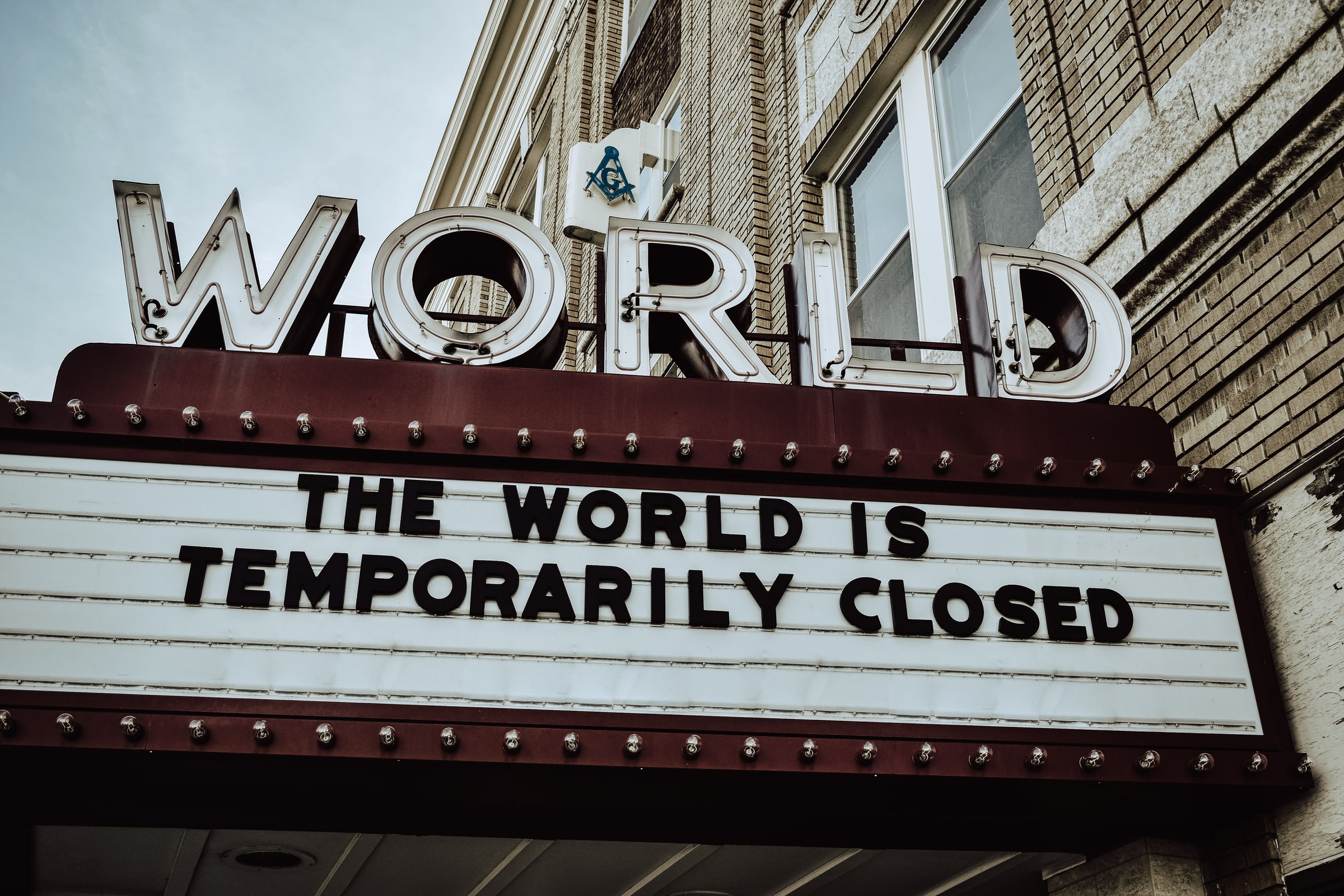13.18: Industry Reaction to COVID-19
- Page ID
- 11486

This section was written by Jan Thompson & Gary Melville.
Unprecedented Times
At of January 20, 2021 the total tally of global cases of COVID-19 stood at 96.5 million, with a death toll of more than 2.1 million. The pandemic has impacted over 213 global countries and territories as well as 2 international conveyances and has caused governments to enact various measures to reduce the spread of the virus. No region of the globe has been left untouched, from island archipelagos in the Pacific and the Caribbean to the developed countries of North America and Europe, and the emerging and developing economies of Latin America, the Middle East, Africa, and Asia.
COVID-19 resulted in the closure of borders and the implementation of stay-at-home orders, causing significant economic impact. The supply and demand shocks resulting from COVID-19 affected all segments of the global economy. Impacts were particularly severe on economic sectors that depend on high levels of human interaction such as tourism and travel-related industries. All sectors of the hospitality industry, including restaurants, hotels, tourism, and recreation, typically include direct human contact under normal operation, resulting in the need for social distancing protocols and other modifications during the pandemic. Stay-at-home orders and travel restrictions provided unique challenges for hospitality organizations, above those faced by other industries and sectors.
Hospitality in a Pandemic
The impact of the pandemic affected the position of the hospitality industry as the worlds’ leading economic sector. Prior to the pandemic, the hospitality sector was a leading contributor to GDP and employment worldwide. COVID-19 has altered the ability and desire to travel, affecting all sectors of the industry.
The International Labour Organization estimates 81 million global job losses in 2020 due to COVID-19. It would come as no surprise that job losses in customer service focused industries, such as hospitality, would be proportionately higher than other industries. Along with restaurants and hotels, airlines, cruise lines, and so many other hospitality businesses were required to close their doors or significantly alter their operations to meet safety standards and decreased demand. The impact has spread beyond hospitality employers to businesses in their supply chain and employees of those organizations.

Photo by Edwin Hooper on Unsplash
Industry Response
Most hospitality organizations are familiar with uncertainty, from seasonality and unpredictable patronage to weather and natural disasters impacting operations. However, the COVID-19 pandemic has caused an unprecedented level of disruption to the industry. In addition to fluctuations in consumer demand, businesses have been challenged by adhering to ever-changing government regulations. Many restaurants have had to shift from providing outdoor dining to exclusively take-out, overnight. In addition to the strain this uncertainty puts on the supply chain, employees are left to wonder if they will have a job the next day.
Many operations have come up with creative strategies for serving their customers in the pandemic environment. Traditionally full-service restaurants created makeshift drive-thru stations for guests to order takeout. From fast-food to fine-dining, restaurateurs created family meal packages to simplify the order process for customers and the fulfillment process for staff. Some operations offered to-go alcohol selections, with specific permission by amendment of local codes and statutes. Hotels and resorts promoted "staycation" packages featuring room service, outdoor entertainment, and recreation options. Countless enjoy-from-your-vehicle attractions were hosted from drive-in concerts and movies to drive-through holiday spectacles. Although some hospitality organizations did not have the opportunity to pivot in these ways, many were able to get creative and find a way to keep their customers happy and their staff working.
An Uncertain Future
There is uncertainty facing every aspect of COVID-19. That uncertainty evolved from concern about infectiousness and lethality to the time needed to develop and deploy vaccines. Current uncertainty surrounds the speed of recovery of economies after the pandemic ends and the rate at which consumer spending and travel will return to pre-pandemic levels. This uncertainty extends to the tourism market which presents a range of possible scenarios based on the pandemic’s impact and how it will continue to affect travel and tourism.
As world economies begin to reopen, the challenges faced by the hospitality sector have become quite apparent. While many businesses used the pandemic as an opportunity to pivot to online and remote operation, this strategy is not possible for most hospitality organizations, where customer interaction is key to success. Hospitality operations have taken every precaution to prevent the spread of COVID-19, with concern for both customers and employees. This pandemic presents a unique challenge to the hospitality industry and its leadership. The COVID-19 pandemic has raised several legal issues including the risk of lawsuits by employees who have been laid-off or terminated and by customers who may have been infected during their time at a hotel or restaurant.

Photo by Anastasiia Chepinska on Unsplash
The Way Forward Post COVID-19
It is clear that uncertainty will linger in the hospitality sector while the global pandemic persists, both during and after COVID-19. It will be a long road to revive the tourism and travel sector and other industry segments.
Rebuilding Confidence
Having strict safety and hygiene standards are key to rebuilding consumer confidence for tourism destinations and hospitality organizations. Public relations will play a big part in how organizations communicate their efforts and restore consumer confidence.
Regional Cooperation
Experts in the travel and tourism sector indicate that resumption in travel is likely to follow a trend based on proximity. Travelers will likely begin by visiting local destinations which can be reached by car. This may be followed by overnight stays within the region. Finally, travelers will begin to resume air travel and visiting international destinations. Some regions are adopting “travel bubbles” allowing travel within a “bubble” of neighboring countries or states without the need for long periods of quarantine (Hendersen, 2020). Bubbles have already been established between China and South Korea, between Australia and New Zealand, between Israel, Greece, and Cyprus, and in the Baltic countries. Additional collaboration is being explored in other regions like the Caribbean and Southeast Asia.
Training
Consideration will need to be given to the training and re-training of staff as regulations change and best-practices immerge. Based on industry recommendations, key areas of training might include:
- Training workers to become multi-functional and be able to fill other roles
- COVID-19 training by functional area: reception, housekeeping, maintenance, etc.
- COVID-19 training in hygiene and sanitation
- Guest interaction while maintaining social distancing
- Public health and OSHA requirements for the jurisdiction
- Training in how to deal with suspected COVID-19 cases
- Training in the use of appropriate personal protective equipment (PPE)

Photo by NappyStock on Nappy
Conclusion
The global challenges from COVID-19 facing the hospitality industry have reduced travel and occupancy rates, increased unemployment, and threaten the bottom line of hospitality companies if cases and deaths due to the pandemic continue to rise. As the world seeks to adjust to the realities of the pandemic, maintaining good hygiene and social distancing seems to be the few steps that have worked to prevent viral spread. The response and revival of the tourism and travel sector is an ongoing process that is likely to take some time as the pandemic persists and uncertainty reigns.
References
"COVID-19 Dashboard" by COVID-19 Dashboard by the Center for Systems Science and Engineering (CSSE) at Johns Hopkins University. All Rights Reserved.
"81 million jobs lost as COVID-19 creates turmoil in Asia-Pacific labour markets" by International Labour Organization. Data shared with permission.

